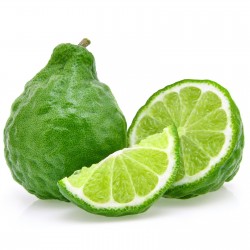Menu
-
MenuBack
- Home
-
Categories
-
-
Categories
-
Vegetable Seeds
-
Varieties by Country
- Varieties from Armenia
- Varieties from BiH
- Varieties from Croatia
- Varieties from France
- Varieties from Germany
- Varieties from Greece
- Varieties from Hungary
- Varieties from India
- Varieties from Italy
- Varieties from Japan
- Varieties from North Macedonia
- Varieties from Peru
- Varieties from Russia
- Varieties from Serbia
- Varieties from Slovenia
- Varieties from Spain
- Varieties from Thailand
- Varieties from Turkey
- Varieties from USA
- Tomato Seeds
- Corn Seeds
- Gourd family
- Bean family
- Cucumber Seeds
- Pepper Seeds
- Carrot family
- Onion family
- Lettuce Seeds
- Potato family
- Cabbage family
- Radish Seeds
- Beetroot family
- Watermelon Seeds
- Melon Seeds
- Cauliflower Seeds
- Sunflower family
-
Varieties by Country
- Fruit Seeds
- Chili - Habanero Seeds
- Medicinal Herb Seeds
- Climbing Plants Seeds
- Trees Bonsai Seeds
- Palm Seeds
- Ornamental Grasses Seeds
- Tobacco Seeds
-
Vegetable Seeds
-
-
-
-
- NEW PRODUCTS
- Create account
- Delivery - Payment
- FAQ
Last Product Reviews
Out of the two seeds, one germinated and the other one was dead and floatin...
By
 Riikka H on 07/03/2024
Riikka H on 07/03/2024
Verified Purchase
There are 389 products.
Showing 331-345 of 389 item(s)

Giant plant (with giant fruits)

Plant resistant to cold and frost

Variety from Japan

Coming Soon
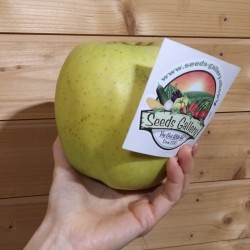
Giant Mutsu apple seeds...
Price
€4.50
(SKU: V 74 M)
Seeds Gallery EU,
5/
5
<!DOCTYPE html>
<html>
<head>
<meta http-equiv="Content-Type" content="text/html; charset=UTF-8" />
</head>
<body>
<h2></h2>
<h2><strong>Giant Mutsu apple seeds<br /></strong></h2>
<h2><span style="color: #ff0000;"><strong>Price for Package of 5 seeds.</strong></span></h2>
<p>The Mutsu (陸奥, ムツ) apple (also known as Crispin) was introduced in 1949 and is a cross between the 'Golden Delicious' and the 'Indo' apple cultivars first grown in Aomori Prefecture, Japan. The apple's name is the former name of a large section of the Tōhoku region, Mutsu Province, from which Aomori was created during the Meiji Restoration.</p>
<p>'Mutsu' is a triploid cultivar. It is highly susceptible to the disease Blister Spot.</p>
<p>'Mutsu' is a large green apple <strong>(fruits weight up to 1 kg)</strong> with flesh varying in color from white to greenish-yellow. It can be round, conical, or oblong, and have unequal sides. It is generally not uniform in shape or size. The russeting on a 'Mutsu' apple covers little to none of the skin and when it is present is light gray to brown.</p>
<p>Usage<br />'Mutsu' is aromatic, sweet, and sharp, with juicy flesh. It is suitable for eating on its own, juicing, drying, or cooking, as it maintains its shape well when cooked. It can be kept for up to three months before going bad.</p>
<p>Cultivation<br />'Mutsu' can be grown in temperate or warm climates. It flowers in the middle of the growing season and is harvested late in the season.</p>
</body>
</html>
V 74 M


Plant resistant to cold and frost
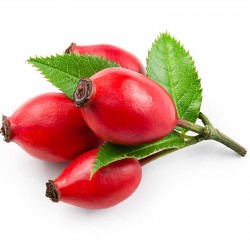
Rose Hip Seeds - Rose Haw -...
Price
€2.15
(SKU: MHS 122)
Seeds Gallery EU,
5/
5
<h2><strong>Rose Hip Seeds - Rose Haw - Rose Hep (Rosa canina)</strong></h2>
<h2><span style="color: #ff0000;"><strong>Price for Package of 1g (65+-) seeds.</strong></span></h2>
<p>The rose hip, also known as rose haw or rose hep, is the fruit of the rose plant, that typically is red-to-orange, but ranges from dark purple to black in some species. Rose hips begin to form after successful pollination of flowers in spring or early summer and ripen in late summer through autumn.</p>
<p><strong>Usage</strong></p>
<p>Rose hips are used for tisanes, jam, jelly, syrup, soup, beverages, pies, bread, wine, and marmalade. They can also be eaten raw, like a berry, if care is used to avoid the hairs inside the fruit.</p>
<p>A few rose species are sometimes grown for the ornamental value of their hips, such as Rosa moyesii, which has prominent large red bottle-shaped fruits.</p>
<p>Rose hips have recently[when?] become popular as a healthy treat for pet chinchillas and guinea pigs. These small rodents are unable to manufacture their own vitamin C and are unable to digest many vitamin-C rich foods. Rose hips provide a sugarless, safe way to increase their vitamin C intake.</p>
<p>Rose hips are also fed to horses. The dried and powdered form can be fed at a maximum of 1 tablespoon per day to improve coat condition and new hoof growth.</p>
<p>The fine hairs found inside rose hips are used as itching powder. Dried rose hips are also sold for primitive crafts and home fragrance purposes.</p>
<p>Rose hips were used in many food preparations by the indigenous peoples of the Americas.</p>
<p> Rose hips can be used to make Palinka, a traditional Hungarian alcoholic beverage. They are also the central ingredient of Cockta, the fruity-tasting national soft drink of Slovenia.</p>
<p>In his book Stalking the Faraway Places, wild foods enthusiast Euell Gibbons recommended stuffed rose hips made by slicing a large hip in half, removing the seeds and inserting a wild raspberry.</p>
<p>Rose hips are commonly used as a tisane, often blended with hibiscus, and also as an oil. They can also be used to make jam, jelly, marmalade, and rose hip wine. Rose hip soup, "nyponsoppa", is especially popular in Sweden. Rhodomel, a type of mead, is made with rose hips.</p>
<p><strong>Medical uses</strong></p>
<p>Rose hips are particularly high in vitamin C content, one of the richest plant sources available. However, RP-HPLC assays of fresh rose hips and several commercially available products revealed a wide range of L-ascorbic acid content, ranging from 0.03 to 1.3%.[2] Rose hips of some species, especially Rosa canina (Dog Rose) and R. majalis, have been used as a source of vitamin C. During World War II, the people of Britain were encouraged through letters to The Times newspaper, articles in the British Medical Journal, and pamphlets produced by Claire Loewenfeld, a dietitian working for Great Ormond Street Hospital for Sick Children, to gather wild-grown rose hips and to make a vitamin C syrup for children. This was because German submarines were sinking many commercial ships: citrus fruits from the tropics were very difficult to import.</p>
<p>Rose hips contain plenty of lycopene, an important and strong antioxidant that prevents oxidation of low density lipoprotein (LDL) as well as of many cellular membranes.[3] Lycopene in rose hips differs more in its isomer distribution than in other sources (tomatoes, pink grapefruit).[citation needed]</p>
<p>Rose hips also contain some vitamin A and B, essential fatty acids, and antioxidant flavonoids.</p>
<p>A study of a rose hip preparation for treating rheumatoid arthritis concluded that there was a benefit, apparently due to both anti-inflammatory and anti-oxidant effects.</p>
<p>Rose hips are used to help prevent colds and influenza.</p>
<p><strong>Propagation</strong></p>
<p>Roses are propagated from hips by removing the achenes that contain the seeds from the hypanthium (the outer coating) and sowing just beneath the surface of the soil. The seeds can take many months to germinate. Most species require chilling (stratification), with some such as Rosa canina only germinating after two winter chill periods have occurred.</p><script src="//cdn.public.n1ed.com/G3OMDFLT/widgets.js"></script>
MHS 122 (1g)


Medicinal or spice plant
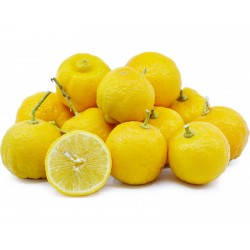
Palestinian sweet lime...
Price
€2.25
(SKU: V 119 CL)
Seeds Gallery EU,
5/
5
<h2><strong>Palestinian sweet lime seeds (Citrus limettioides)</strong></h2>
<h2><span style="color: #ff0000;"><strong>Price for Package of 2 seeds.</strong></span></h2>
<p>Citrus limettioides, Palestinian sweet lime or Indian sweet lime or common sweet lime, alternatively considered a cultivar of Citrus × limon, C. × limon 'Indian Lime', is a low acid lime that has been used in Palestine for food, juice, and rootstock.</p>
<p>Indian sweet lime is a small evergreen tree with few thorns, growing 4 - 6 meters tall.<br>The tree is sometimes cultivated for its edible fruit, especially in India, the Mediterranean region, Vietnam, and tropical America</p>
<p>It is a member of the sweet limes. Like the Meyer lemon, it is the result of a cross between the citron (Citrus medica) and a mandarin/pomelo hybrid distinct from sweet and sour oranges.</p>
<p><strong>Edible Uses</strong></p>
<p>Fruit - raw, cooked, or preserved. A succulent, acidic-sweet pulp. A soft drink is made from the juice.</p>
<p><strong>Medicinal</strong></p>
<p>The fruit has medicinal properties.<br>Citrus species contain a wide range of active ingredients and research is still underway in finding uses for them. They are rich in vitamin C, flavonoids, acids, and volatile oils. They also contain coumarins such as bergapten which sensitizes the skin to sunlight. Bergapten is sometimes added to tanning preparations since it promotes pigmentation in the skin, though it can cause dermatitis or allergic responses in some people. Some of the plants more recent applications are as sources of anti-oxidants and chemical exfoliants in specialized cosmetics.<br>Other Uses<br>Essential oil is obtained from the peel of the fruit.</p>
<p>The plant is used as a rootstock for other Citrus species.</p><script src="//cdn.public.n1ed.com/G3OMDFLT/widgets.js"></script>
V 119 CL

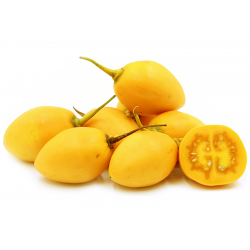
Yellow Tamarillo Seeds...
Price
€2.15
(SKU: V 159)
Seeds Gallery EU,
5/
5
<!DOCTYPE html>
<html>
<head>
<meta http-equiv="Content-Type" content="text/html; charset=UTF-8" />
</head>
<body>
<h2><strong>Yellow Tamarillo Seeds (Golden Tamarillo)</strong></h2>
<h2><span style="color: #ff0000;"><strong>Price for Package of 5 seeds.</strong></span></h2>
<p>It is still hard to find Yellow tamarillo seeds. Yellow tamarillo fruit is egg-shaped with a glossy tangerine hued skin and succulent flesh containing small soft edible seeds. The skin is thin and tannin-rich for palatable human consumption. Its flesh when is ripe is bright and piquant in flavor with a pleasantly sweet aroma.</p>
<p>The Golden tamarillo, botanical name Cyphomandra betacea, is also known as the tree tomato, is a member of the Solanaceae family which includes tomatoes, potatoes, tobacco, and pepper plants.</p>
<h2><strong>WIKIPEDIA:</strong></h2>
<div><span>The </span><b>tamarillo</b><span> is a small tree or </span>shrub<span> in the </span>flowering plant<span> family </span>Solanaceae<span> (the nightshade family). It is best known as the species that bears the </span><b>tamarillo</b><span>, an egg-shaped edible </span>fruit<span>.</span><span> It is also known as the </span><b>tree<span> </span>tomato</b><span>,</span><span> </span><b>tomate andino</b><span>, </span><b>tomate serrano</b><span>, </span><b>tomate de<span> </span>yuca</b><span>, </span><b>sachatomate</b><span>, </span><b>berenjena</b><span>, </span><b>tamamoro</b><span>, and </span><b>tomate de árbol</b><span> in South America.</span></div>
<div></div>
<div>
<h3><span class="mw-headline" id="Plant_origin_and_regions_of_cultivation">Plant origin and regions of cultivation</span></h3>
<p>The tamarillo is native to the Andes of Ecuador, Colombia, Peru, Chile, and Bolivia. Today it is still cultivated in gardens and small orchards for local production,<sup id="cite_ref-SmallFruitsReview_4-0" class="reference">[4]</sup> and it is one of the most popular fruits in these regions.<sup id="cite_ref-economicBotany_5-0" class="reference">[5]</sup> Other regions of cultivation are the subtropical areas throughout the world, such as Rwanda, South Africa, Darjeeling, and Sikkim in India, Nepal, Hong Kong, China, the United States, Australia, Bhutan, and New Zealand.</p>
<p>The first internationally marketed crop of tamarillos in Australia was produced around 1996, although permaculture and exotic fruit enthusiasts had increasingly grown the fruit around the country from the mid-1970s on.</p>
<p>In New Zealand, about 2,000 tons are produced on 200 hectares of land and exported to the United States, Japan, and Europe. For the export, the existing marketing channels developed for the kiwifruit are used.</p>
<p>The tamarillo is also successfully grown at higher elevations of Malaysia and the Philippines, and in Puerto Rico. In the hot tropical lowlands, it develops only small fruits and fruit setting is seldom.</p>
<p>Prior to 1967, the tamarillo was known as the "tree<span> </span>tomato" in New Zealand, but a new name was chosen by the New Zealand Tree<span> </span>Tomato<span> </span>Promotions Council in order to distinguish it from the ordinary garden tomatoand increase its exotic appeal.</p>
</div>
<h3><span class="mw-headline" id="Plant">Plant</span></h3>
<div class="thumb tright">
<div class="thumbinner"><img alt="" src="https://upload.wikimedia.org/wikipedia/commons/thumb/3/31/Cyphomandra_betacea1.jpg/220px-Cyphomandra_betacea1.jpg" width="220" height="165" class="thumbimage" data-pagespeed-url-hash="2010095046" onload="pagespeed.CriticalImages.checkImageForCriticality(this);" />
<div class="thumbcaption">
<div class="magnify"></div>
Flower cluster</div>
</div>
</div>
<p>The plant is a fast-growing tree that grows up to 5 meters. Peak production is reached after 4 years,<sup id="cite_ref-LostCrops_6-1" class="reference">[6]</sup> and the life expectancy is about 12 years.<sup id="cite_ref-SmallFruitsReview_4-3" class="reference">[4]</sup> The tree usually forms a single upright trunk with lateral branches. The flowers and fruits hang from the lateral branches. The leaves are large, simple and perennial, and have a strong pungent smell.<sup id="cite_ref-LostCrops_6-2" class="reference">[6]</sup> The flowers are pink-white and form clusters of 10 to 50 flowers. They produce 1 to 6 fruits per cluster. Plants can set fruit without cross-pollination, but the flowers are fragrant and attract insects. Cross-pollination seems to improve fruit set.<sup id="cite_ref-LostCrops_6-3" class="reference">[6]</sup> The roots are shallow and not very pronounced, therefore the plant is not tolerant of drought stress and can be damaged by strong winds. Tamarillos will hybridize with many other<span> </span>Solanaceae, though the hybrid fruits will be sterile, and unpalatable in some instances.</p>
<h3><span class="mw-headline" id="Fruit">Fruit</span></h3>
<div class="thumb tright">
<div class="thumbinner"><img alt="" src="https://upload.wikimedia.org/wikipedia/commons/thumb/9/9a/Solanum_betaceum_unripe_fruits.jpg/220px-Solanum_betaceum_unripe_fruits.jpg" width="220" height="146" class="thumbimage" data-pagespeed-url-hash="2489475574" onload="pagespeed.CriticalImages.checkImageForCriticality(this);" />
<div class="thumbcaption">
<div class="magnify"></div>
Unripe fruits</div>
</div>
</div>
<div class="thumb tright">
<div class="thumbinner"><img alt="" src="https://upload.wikimedia.org/wikipedia/commons/thumb/0/00/Tamarillos%28janek2005%29.jpg/220px-Tamarillos%28janek2005%29.jpg" width="220" height="182" class="thumbimage" data-pagespeed-url-hash="1269263135" onload="pagespeed.CriticalImages.checkImageForCriticality(this);" />
<div class="thumbcaption">
<div class="magnify"></div>
Ripe fruits</div>
</div>
</div>
<p>The fruits are egg-shaped and about 4-10 centimeters long. Their color varies from yellow and orange to red and almost purple. Sometimes they have dark, longitudinal stripes. Red fruits are more acetous, yellow and orange fruits are sweeter. The flesh has a firm texture and contains more and larger seeds than a common tomato.<sup id="cite_ref-SmallFruitsReview_4-4" class="reference">[4]</sup> The fruits are very high in vitamins and iron and low in calories (only about 40 calories per fruit).</p>
<h3><span class="mw-headline" id="Soil_and_climate_requirements">Soil and climate requirements</span></h3>
<p>The tamarillo prefers a subtropical climate, with rainfall between 600 and 4000 millimeters and annual temperatures between 15 and 20 °C.<sup id="cite_ref-SmallFruitsReview_4-6" class="reference">[4]</sup> It is intolerant to frost (below -2 °C) and drought stress. It is assumed that the fruit set is affected by night temperatures. Areas, where citrus is cultivated, provide good conditions for tamarillos as well, such as in the Mediterranean climate. Tamarillo plants grow best in light, deep, fertile soils, although they are not very demanding. However, soils must be permeable since the plants are not tolerant of water-logging.<sup id="cite_ref-SmallFruitsReview_4-7" class="reference">[4]</sup> They grow naturally on soils with a pH of 5 to 8.5.</p>
<h3><span class="mw-headline" id="Growth">Growth</span></h3>
<p>Propagation is possible by both using seeds or cuttings.<sup id="cite_ref-SmallFruitsReview_4-8" class="reference">[4]</sup><sup id="cite_ref-7" class="reference">[7]</sup> Seedlings first develop a straight, about 1.5 to 1.8 meters tall trunk, before they branch out. Propagation by seeds is easy and ideal in protected environments. However, in orchards with different cultivars, cross-pollination will occur and the characteristics of the cultivars get mixed up. Seedlings should be kept in the nursery until they reach a height of 1 to 1.5 meters, as they are very frost-sensitive.</p>
<p>Plants grown from cuttings branch out earlier and result in more shrub-like plants that are more suitable for exposed sites. Cuttings should be made from basal and aerial shoots and should be free of pathogenic viruses. Plants grown from cuttings should be kept in the nursery until they reach a height of 0.5 to 1 meter.</p>
<p>The tree grows very quickly and is able to bear fruit after 1.5 to 2 years. The plant is daylength-insensitive. The fruits do not mature simultaneously unless the tree has been pruned. A single tree can produce more than 20 kg of fruit per year; an orchard yields in 15 to 17 tons per hectare.<sup id="cite_ref-LostCrops_6-5" class="reference">[6]</sup> One single mature tree in good soil will bear more fruit than a typical family can eat in about 3 months.</p>
<p>Tamarillos are suitable for growing as indoor container plants, though their swift growth, their light, water, and humidity requirements, and their large leaves can pose a challenge to those with limited space.</p>
<h3><span class="mw-headline" id="Plant_management">Plant management</span></h3>
<div class="thumb tright">
<div class="thumbinner"><img alt="" src="https://upload.wikimedia.org/wikipedia/commons/thumb/0/0a/Cyphomandra_betacea2.jpg/220px-Cyphomandra_betacea2.jpg" width="220" height="293" class="thumbimage" data-pagespeed-url-hash="353362248" onload="pagespeed.CriticalImages.checkImageForCriticality(this);" />
<div class="thumbcaption">
<div class="magnify"></div>
Tamarillo tree</div>
</div>
</div>
<p>The tamarillo trees are adaptable and very easy to grow. However, some plant management strategies can help to stabilize and improve plant performance.</p>
<h4><span class="mw-headline" id="Planting">Planting</span></h4>
<p>Planting distances depend on the growing system. In New Zealand, with mechanized production, single row planting distances of 1 to 1.5 meters between plants and 4.5 to 5 meters between rows are recommended. In traditional growing regions such as the Andean region, plantations are much denser, with 1.2 to 1.5 meters between plants. Dense planting can be a strategy to protect plants against the wind. On poorly drained soils, plants should be planted on ridges.</p>
<h4><span class="mw-headline" id="Pruning">Pruning</span></h4>
<p>Pruning can help to control fruit size, plant size, harvest date and to simplify the harvesting of fruits.<sup id="cite_ref-SmallFruitsReview_4-10" class="reference">[4]</sup> Cutting the tip of young plants leads to the desired branch height. Once the tree shape has been formed, pruning is reduced to the removal of old or dead wood and previously fruited branches, since branches that have already carried fruits will produce smaller fruits with lower quality the next time. Light pruning leads to medium-sized, heavy pruning to large-sized fruits. Basal shoots should be removed. When plants are grown in greenhouses, pruning prevents excessive vegetative growth.</p>
<p>When the tree is about 1 to 1.5 meters in height, it is advisable to cut the roots on one side and lean the tree to the other (in the direction of the midday sun at about 30 to 45 degrees). This allows fruiting branches to grow all along the trunk rather than just at the top.</p>
<div class="thumb tright">
<div class="thumbinner"><img alt="" src="https://upload.wikimedia.org/wikipedia/commons/thumb/e/e3/Tamarillo_seedlings%2C_6_months_old.jpg/220px-Tamarillo_seedlings%2C_6_months_old.jpg" width="220" height="215" class="thumbimage" data-pagespeed-url-hash="1025451796" onload="pagespeed.CriticalImages.checkImageForCriticality(this);" />
<div class="thumbcaption">
<div class="magnify"></div>
Tamarillo seedlings, 6 months old</div>
</div>
</div>
<h4><span class="mw-headline" id="Mulching">Mulching</span></h4>
<p>Since the plants are sensitive to drought stress, mulching can help to preserve moisture in the soil.<sup id="cite_ref-LostCrops_6-6" class="reference">[6]</sup> It can also be a strategy to suppress weeds, as other soil management techniques, such as plowing, are not possible due to the shallow and sensitive root system.</p>
<h4><span class="mw-headline" id="Shelter">Shelter</span></h4>
<p>The plants have to be protected from the wind. Their shallow root system does not provide enough stability, and the lateral branches are fragile and break easily when carrying fruits.<sup id="cite_ref-SmallFruitsReview_4-11" class="reference">[4]</sup></p>
<h4><span class="mw-headline" id="Irrigation_and_fertilization">Irrigation and fertilization</span></h4>
<p>To maximize and stabilize production, water, and nutrient inputs should be provided when needed. The plants need a continuous supply of water due to their shallow root system. Drought stress results in a decrease in plant growth, fruit size, and productivity.<sup id="cite_ref-SmallFruitsReview_4-12" class="reference">[4]</sup> Recommended fertilizer rates per hectare are 170 kg of Nitrogen, 45 kg of Phosphorus, and 130 to 190 kg of Potassium for intensive New Zealand production systems. Phosphorus and Potassium are applied at the beginning of the season, Nitrogen applications are distributed throughout the year.</p>
<h4><span class="mw-headline" id="Pest_management">Pest management</span></h4>
<p>The tamarillo tree is, compared to similar crops such as tomatoes, quite resistant to pests in general. Still, to reduce risk in intensive production systems, some pests have to be controlled to avoid major crop damage. To control pests, the same control methods as other Solanaceae can be used.</p>
<h3><span class="mw-headline" id="Harvest">Harvest</span></h3>
<p>Ripening of fruits is not simultaneous. Several harvests are necessary.<sup id="cite_ref-8" class="reference">[8]</sup> In climates with little annual variation, tamarillo trees can flower and set fruit throughout the year. In climates with pronounced seasons (such as New Zealand), fruits ripen in autumn. Premature harvest and ethylene-induced ripening in controlled-atmosphere chambers are possible with minimal loss of fruit quality.<sup id="cite_ref-Ripening_9-0" class="reference">[9]</sup> The fragile lateral branches can break easily when loaded with fruits, so premature harvest helps to reduce this risk and allows storage of fruits up to 20 days at room temperature. A cold-water dipping process, developed by the New Zealand Department of Scientific and Industrial Research also allows further storage of 6–10 weeks.</p>
<h2><span class="mw-headline" id="Usage">Usage</span></h2>
<h3><span class="mw-headline" id="Culinary_use">Culinary use</span></h3>
<p>The fruit is eaten by scooping the flesh from a halved fruit. When lightly sugared and cooled, the flesh is used for a breakfast dish. Some people in New Zealand cut the fruit in half, scoop out the pulpy flesh and spread it on toast at breakfast. Yellow-fruited cultivars have a sweeter flavor, occasionally compared to mango or apricot. The red-fruited variety, which is much more widely cultivated, is more tart, and the savory aftertaste is far more pronounced. In the Northern Hemisphere, tamarillos are most frequently available from July until November, and fruits early in the season tend to be sweeter and less astringent.</p>
<p>They can be made into compotes, or added to stews (e.g. Boeuf Bourguignon), hollandaise, chutneys, and curries. Desserts using this fruit include bavarois and, combined with apples, a strudel.</p>
<p>Tamarillos can be added as a secondary fermentation flavoring to Kombucha Tea for a tart and tangy taste. The fruit should be mashed and added at a ratio of 3 Tamarillos to 1 Litre of Kombucha, however, great care should be taken to not allow too much carbon dioxide gas to build up in sealed bottles during secondary fermentation. The sugar content of fresh Tamarillos added to Kombucha can generate rapid carbon dioxide production in secondary fermentation within just 48–72 hours.</p>
<p>In Colombia, Ecuador, Panama, and parts of Indonesia (including Sumatra and Sulawesi), fresh tamarillos are frequently blended together with water and sugar to make a juice. It is also available as a commercially pasteurized purée.</p>
<p>In Nepal, a version of the South American fruit is decently popular. It is typically consumed as a chutney or a pickle during the autumn and winter months. It is known as <i>Tammatar</i> and <i>Ram Bheda</i>. Similar to Nepal, the Indian regions of Ooty, Darjeeling, and Sikkim also consume Tamarillo.</p>
<p>In Ecuador, the tamarillo, known as <i>tomate de árbol</i>, is blended with chili<span> </span>peppers<span> </span>to make a hot sauce commonly consumed with local dishes of the Andean region. The sauce is simply referred to as <i>aji</i> and is present at every meal in Ecuador.</p>
<p>The flesh of the tamarillo is tangy and variably sweet, with a bold and complex flavor, and maybe compared to kiwifruit,<span> </span>tomato, guava, or passion fruit. The skin and the flesh near it have a bitter taste and are not usually eaten raw</p>
<p>The tamarillo has been described as having a taste similar to that of a passion fruit and a piquant tomato combined.</p>
<p>The red and purple types of fruits are preferred in import countries of Europe: Even though they taste more acidic, their color is favored by consumers.</p>
<h3><span class="mw-headline" id="Industrial_use">Industrial use</span></h3>
<p>The fruits are high in pectin and therefore have good properties for preserves. However, they oxidize and lose color when not treated. Yellow fruit types are better suited for industrial use.</p>
<h2><span class="mw-headline" id="Prospects">Prospects</span></h2>
<p>Research and breeding should improve plantation management, fruit quality, and postharvest treatment.<sup id="cite_ref-LostCrops_6-7" class="reference">[6]</sup> A better understanding of plant physiology, nutritional requirements of plants, and fruit set mechanisms will help to improve growing systems. Breeding goals are to break seed dormancy, to improve the sweetness of fruits, and to increase yield. For industrial uses, little "stones" of sodium and calcium that occasionally appear in the fruit skin form a problem. Those stones have to be eliminated by breeding.</p>
</body>
</html>
V 159 (5 S)

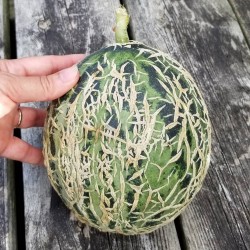
Casca de Carvalho Melon Seeds
Price
€2.10
(SKU: V 34)
Seeds Gallery EU,
5/
5
<meta http-equiv="Content-Type" content="text/html; charset=UTF-8" />
<h2><strong>Casca de Carvalho Melon Seeds</strong></h2>
<h2><span style="color: #ff0000;"><strong>Price for a Package of 10 seeds.</strong></span></h2>
<p>Very old rare Portuguese heirloom with an excellent taste and Oblong and rounded fruit with an average weight of 3 to 4 kg from the north of Portugal.</p>
<p>The skin is cream-colored with fine and dense lattice. The pulp is salmon pink, very sugary. This type of melon has a unique spicy flavor and it’s very juicy, which makes it a highly requested product in fairs and festivities. Therefore, its uniqueness makes this melon a product with a high level of commercialization.</p>
<p>Also known as "Écorce de chêne" because of its shell reminiscent of that of an oak.</p>
V 34 (10 S)


Variety from Japan
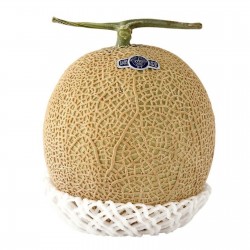
Shizuoka Crown Melon Seeds
Price
€7.45
(SKU: V 2 SC)
Seeds Gallery EU,
5/
5
<!DOCTYPE html>
<html>
<head>
<meta http-equiv="Content-Type" content="text/html; charset=UTF-8" />
</head>
<body>
<h2><strong>Shizuoka Crown Melon Seeds</strong></h2>
<h2><span style="color: #ff0000;"><strong>Price for Package of 5, 10, 50 seeds.</strong></span></h2>
<p>The "Shizuoka Crown Melon" has the beauty of artistic form, a fragrance with the scent of musk, plenty of juice, mellow taste, and smooth texture, which is the high-grade melon cultivated in Fukuroi city of Shizuoka prefecture, called “Shizuoka Crown Melon”. “Shizuoka Crown Melon” is cultivated with sophisticated techniques of growers and grown absolutely in greenhouses. In other words, the ultimate taste of “Shizuoka Crown Melon”, which was born by outstanding virtuosity of professionals, has been taken over from generation to generation.</p>
<p>The melon has been presented to the Japanese royal family for a long time and recognized as an elegant and prestigious fruit in Japan. Many VIPs also love Crown Melon. When the queen of the United Kingdom came to Japan and ate Crown Melon, we got words of praise.</p>
</body>
</html>
V 2 SC (10S)


Plant resistant to cold and frost

Coming Soon
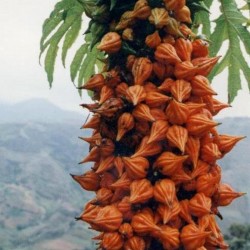
Rare Papaya Carica...
Price
€18.00
(SKU: V 22 CW)
Seeds Gallery EU,
5/
5
<h2 class=""><strong>Rare Papaya Carica weberbaueri Seeds</strong></h2>
<h2><span style="color: #ff0000;"><strong>Price for Package of 5 seeds.</strong></span></h2>
<div><span style="color: #333333; font-size: 17px;">A rare and little known, sparsely<span> </span></span><a href="https://www.rarepalmseeds.com/" class="title" title="branched|Split into two or more parts." style="color: #333333; font-size: 17px;">branched</a><span style="color: #333333; font-size: 17px;"><span> </span>shrub or small tree rarely more than 7 m tall with thick branches, large, deeply lobed, palmate leaves and pointed, ridged, orange to red fruits. <br>It is native to montane forests of the Andes in Peru to 3000 m and is cultivated there for its edible, very tasty, aromatic, and refreshing fruits that are eaten fresh, dried, or canned. <br>A liqueur called Cacique is also made from the fruit. Carica weberhaueri tolerates some drought and cold and is best adapted to cultivation in warm<span> </span></span><a href="https://www.rarepalmseeds.com/" class="title" title="temperate|Roughly, a climate where the yearly amplitudes of temperature are greater than the daily amplitudes." style="color: #333333; font-size: 17px;">temperate</a><span style="color: #333333; font-size: 17px;"><span> </span>climates.<br></span></div>
<div>
<table border="1" cellspacing="0" cellpadding="0">
<tbody>
<tr>
<td colspan="2" valign="top" width="100%">
<p><span style="color: #008000;"><strong>Sowing Instructions</strong></span></p>
</td>
</tr>
<tr>
<td valign="top" nowrap="nowrap">
<p><span style="color: #008000;"><strong>Propagation:</strong></span></p>
</td>
<td valign="top">
<p><span style="color: #008000;">Seeds / Cuttings</span></p>
</td>
</tr>
<tr>
<td valign="top" nowrap="nowrap">
<p><span style="color: #008000;"><strong>Pretreat:</strong></span></p>
</td>
<td valign="top">
<p><span style="color: #008000;">0</span></p>
</td>
</tr>
<tr>
<td valign="top" nowrap="nowrap">
<p><span style="color: #008000;"><strong>Stratification:</strong></span></p>
</td>
<td valign="top">
<p><span style="color: #008000;">0</span></p>
</td>
</tr>
<tr>
<td valign="top" nowrap="nowrap">
<p><span style="color: #008000;"><strong>Sowing Time:</strong></span></p>
</td>
<td valign="top">
<p><span style="color: #008000;">all year round</span></p>
</td>
</tr>
<tr>
<td valign="top" nowrap="nowrap">
<p><span style="color: #008000;"><strong>Sowing Depth:</strong></span></p>
</td>
<td valign="top">
<p><span style="color: #008000;">0.5 cm</span></p>
</td>
</tr>
<tr>
<td valign="top" nowrap="nowrap">
<p><span style="color: #008000;"><strong>Sowing Mix:</strong></span></p>
</td>
<td valign="top">
<p><span style="color: #008000;">Coir or sowing mix + sand or perlite</span></p>
</td>
</tr>
<tr>
<td valign="top" nowrap="nowrap">
<p><span style="color: #008000;"><strong>Germination temperature:</strong></span></p>
</td>
<td valign="top">
<p><span style="color: #008000;">about 25-28 ° C</span></p>
</td>
</tr>
<tr>
<td valign="top" nowrap="nowrap">
<p><span style="color: #008000;"><strong>Location:</strong></span></p>
</td>
<td valign="top">
<p><span style="color: #008000;">bright + keep constantly moist not wet</span></p>
</td>
</tr>
<tr>
<td valign="top" nowrap="nowrap">
<p><span style="color: #008000;"><strong>Germination Time:</strong></span></p>
</td>
<td valign="top">
<p><span style="color: #008000;">2-4 Weeks</span></p>
</td>
</tr>
<tr>
<td valign="top" nowrap="nowrap">
<p><span style="color: #008000;"><strong>Watering:</strong></span></p>
</td>
<td valign="top">
<p><span style="color: #008000;">regular watering during the growth period + dry between waterings</span></p>
</td>
</tr>
<tr>
<td valign="top" nowrap="nowrap">
<p><span style="color: #008000;"><strong> </strong></span></p>
</td>
<td valign="top">
<p><br><span style="color: #008000;"><em>Copyright © 2012 Seeds Gallery - Saatgut Galerie - Galerija semena. All Rights Reserved.</em></span></p>
</td>
</tr>
</tbody>
</table>
</div>
V 22 CW


Plant resistant to cold and frost
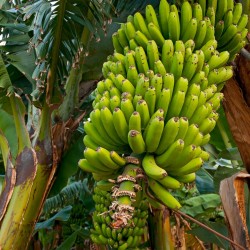
Wild forest banana seeds...
Price
€3.05
(SKU: V 125 MY)
Seeds Gallery EU,
5/
5
<h2><strong>Wild forest banana seeds (Musa yunnanensis )</strong></h2>
<h2><span style="color: #ff0000;"><strong>Price for Package of 3 seeds.</strong></span></h2>
<p style="color: #202122; font-size: 14px;"><strong>A new, cold-tolerant species from the mountains of southwest China.</strong><br>Musa yunnanensis, commonly known as the Yunnan banana or the wild forest banana, is a recently described plant in the banana and plantain family that is native to Yunnan, southern China. The sample was collected in 2005 in Xishuangbanna (an autonomous prefecture on the border with Indochina) at an altitude of 1,150 meters.<br><br>Very fast growing, with slender pseudo stems and bluish petioles. The history of this species in horticultural culture is short but rather confused. We originally introduced it as Ensete wilsonii first because it was misidentified. It was later mistaken for Musa itinerans, but then turned out to be a new species, officially described by Markku Hakkinen in 2007 as Musa yunnanensis. We also had plants for a while as Musa sp. 'Yangtze' in culture.<br><br>Although M. yunnanesis grows in the montane tropical forest, it is both shade and frost tolerant, sensitive to direct sunlight and therefore essentially an underplant. Individuals typically reach a height of about 5 to 5.25 meters as they mature. Bark on pseudo-trunks is coated with wax, which is white with a bluish tinge. The top of the leaves is also bluish, although their undersides are colored red.<br><br>Musa yunnanensis has value to local wildlife, its summer fruits are consumed by birds, bats and possibly elephants. </p>
<p style="color: #202122; font-size: 14px;"></p>
V 125 MY

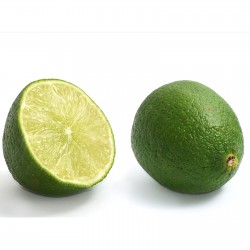
Key lime seeds (Citrus...
Price
€2.25
(SKU: V 119 CAKL)
Seeds Gallery EU,
5/
5
<h2 class=""><strong>Key lime seeds (Citrus aurantiifolia)</strong></h2>
<h2><span style="color: #ff0000;"><strong>Price for Package of 2 seeds.</strong></span></h2>
<p style="color: #202122; font-size: 14px;">The<span> </span><b>Key lime</b><span> </span>(<i>Citrus</i><span> </span>×<span> </span><i>aurantiifolia</i>) is a<span> </span>citrus hybrid<span> </span>(<i>C. hystrix</i><span> </span>x<span> </span><i>C. medica</i>) with a spherical fruit, 25–50 mm (1–2 in) in diameter. The Key lime is usually picked while it is still green, but it becomes yellow when ripe.</p>
<p style="color: #202122; font-size: 14px;">The Key lime is smaller, seedier, has higher acidity, stronger aroma, and thinner<span> </span>rind<span> </span>than the<span> </span>Persian lime<span> </span>(<i>Citrus × latifolia</i>). It is valued for its characteristic flavor. The name comes from its association with the<span> </span>Florida Keys, where it is best known as the<span> </span>flavoring<span> </span>ingredient in<span> </span>Key lime pie. It is also known as<span> </span><b>West Indian lime</b>,<span> </span><b>bartender's lime</b>,<span> </span><b>Omani lime</b>, or<span> </span><b>Mexican lime</b>, the last classified as a distinct<span> </span>race<span> </span>with a thicker skin and darker green color. Philippine varieties have various names, including<span> </span><i><b>dayap</b></i><span> </span>and<span> </span><i>bilolo</i>.</p>
<h2 style="color: #000000; font-size: 1.5em;"><span class="mw-headline" id="Description">Description</span></h2>
<p><i>C. aurantiifolia</i><span> </span>is a shrubby tree, to 5 m (16 ft), with many<span> </span>thorns. Dwarf varieties exist that can be grown indoors during winter months and in colder climates. Its trunk, which rarely grows straight, has many branches, and they often originate quite far down on the trunk. The leaves are ovate, 25–90 mm (1–<span class="frac nowrap">3<span class="visualhide"> </span><sup style="font-size: 11.2px;">1</sup>⁄<sub style="font-size: 11.2px;">2</sub></span> in) long, resembling<span> </span>orange<span> </span>leaves (the scientific name<span> </span><i>aurantiifolia</i><span> </span>refers to this resemblance to the leaves of the orange,<span> </span><i>Citrus aurantium</i>). The<span> </span>flowers<span> </span>are 25 mm (1 in) in diameter, are yellowish-white with a light purple tinge on the margins. Flowers and fruit appear throughout the year but are most abundant from May to September in the Northern Hemisphere.<sup id="cite_ref-purdue1_5-0" class="reference" style="font-size: 11.2px;"></sup></p>
<p>Skin contact can sometimes cause<span> </span>phytophotodermatitis,<sup id="cite_ref-Weber_et_al._1999_6-0" class="reference" style="font-size: 11.2px;"></sup><sup id="cite_ref-7" class="reference" style="font-size: 11.2px;"></sup><span> </span>which makes the skin especially sensitive to<span> </span>ultraviolet<span> </span>light.</p>
<h3 style="color: #000000; font-size: 1.2em;"><strong><span class="mw-headline" id="Cultivation_and_propagation">Cultivation and propagation</span></strong></h3>
<div class="thumb tright" style="color: #202122; font-size: 14px;"><span>There are various approaches to the cultivation of Key limes. This variety of </span>citrus<span> can be propagated from seed and will grow true to the parent.<br><span>If the plants are propagated from seed, the seeds should be stored at least 5–6 months before planting.</span></span></div>
V 119 CAKL


Plant resistant to cold and frost
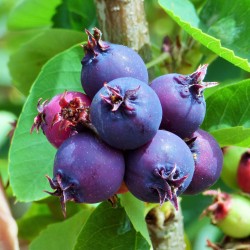
Saskatoon Serviceberry...
Price
€1.65
(SKU: V 208 AA)
Seeds Gallery EU,
5/
5
<h2 class=""><strong>Saskatoon Serviceberry Seeds (Amelanchier alnifolia)</strong></h2>
<div>
<h2><span style="color: #ff0000;"><strong>Price for Package of 5 seeds.</strong></span></h2>
</div>
<div>Amelanchier alnifolia, the saskatoon, Pacific serviceberry, western serviceberry, alder-leaf shadbush, dwarf shadbush, chuckley pear, or western juneberry, is a shrub with edible berry-like fruit, native to North America from Alaska across most of western Canada and in the western and north-central United States.<span style="color: #202122; font-size: 14px;"><span style="color: #202122; font-size: 14px;"><br /></span></span>
<p style="color: #000000; font-size: large;"><span lang="EN" style="font-size: 13pt;">Saskatoon Serviceberry</span><span lang="EN" style="font-size: 13pt;"><span> </span></span><span style="font-size: 13pt;" class="">each year announces their presence in the early springtime when the slender pinkish buds turn to 1-inch white flowers blooming so profusely that the branches are obscured by their feathery petals. The blooms are reminiscent of the witch hazel. Deciduous, ranging in height to 35 feet and up to 20 feet wide, the<span> </span></span><span lang="EN" style="font-size: 13pt;">Saskatoon<span> </span></span><span style="font-size: 13pt;">Serviceberry begins its annual growth cycle with these flowers even before the leaves sprout in their shades of silver or red which turn to green.</span></p>
<p style="color: #000000; font-size: large;"><span style="font-size: 13pt;">The leaves are downy when they are young and similar to those of cherry cultivars. The mature leaf color is dark green or even a slightly blue tint on top, not glossy, and pale on the underside. They are thicker and more firm in texture than the cherry leaves.</span></p>
<p style="color: #000000; font-size: large;"><span style="font-size: 13pt;">After the blooms fade the fruits appear in the latter part of June or early July, hence another of its common names, the Juneberry. These plentiful red-purple fruits are sweet and juicy, soft in texture, and often said to be similar in taste to apples. This is quite natural, as they are a member of the apple family. The fruits are about 1/4 to 1/2 inch in diameter with 2 to 5 very small seeds in the pear or apple-like core. They resemble high bush blueberries in size and shape, but they are not related to the blueberry.</span></p>
<p style="color: #000000; font-size: large;"><span style="font-size: 13pt;">One would think the lovely blooms and delicious fruit would be enough of a gift from these trees, but in autumn the oval or oblong-shaped leaves, 2 to 5 inches long and 1 to 2 inches wide, turn to wondrous shades of yellow-orange to reddish-purple before they fall to carpet the ground beneath.</span></p>
<p style="color: #000000; font-size: large;"><span style="font-size: 13pt;">In winter the overall rounded shape of the branches is pleasing to the eye with their gray to black coloration until the new red-brown twigs start the cycle anew come spring. The bark itself is interesting, tightly holding the trunk(s) and branches, it has very distinctive vertical lines. It becomes more scaly as the tree matures.</span></p>
<p style="color: #000000; font-size: large;"><b><u><span style="font-size: 13pt;">Uses:</span></u></b><span style="font-size: 13pt;"><span> </span>A wonderful landscape plant, the flowers, foliage, and bark are attractive year-round. Not invasive, the Serviceberry can be planted without fear in beds with other shrubs or trees or as specimen plants. Very resistant to air pollution, they can be grown with a single trunk or multiple trunked groves. They make an excellent windbreak when planted fairly close together so the branches can intertwine to form a living fence.</span></p>
<p style="color: #000000; font-size: large;"><span style="font-size: 13pt;">Economically the wood of the Serviceberry is occasionally made into tool handles, but its most common contribution to humans and wildlife is the delicious berries.</span></p>
<p style="color: #000000; font-size: large;"><b><u><span lang="EN" style="font-size: 13pt;">Berries:</span></u></b><span lang="EN" style="font-size: 13pt;"><span> </span>Sweet in taste, the fruits have long been eaten by Canada's Aboriginal people as pemmican, a preparation of dried meat to which Saskatoon berries are added as flavor and preservative. They are also often used in pies, jams, wines, cider, beers, and sugar-infused berries similar to dried cranberries are used for cereals, trail mix and snack foods, Nutritional.<br /></span></p>
<p style="font-size: large;"><b><span style="font-size: 13pt;">Other Names:</span></b><span style="font-size: 13pt;"><span> </span>Saskatoon Serviceberry, Western Serviceberry, Shadbush, Shadblow, Indian pear, Juneberry, May cherry</span></p>
<p style="font-size: large;"><b><span style="font-size: 13pt;">Zone:</span></b><span style="font-size: 13pt;"><span> </span>3 to 10</span></p>
<p style="font-size: large;"><b><span style="font-size: 13pt;">Growth Rate:</span></b><span style="font-size: 13pt;"><span> </span>Medium</span></p>
<p style="font-size: large;"><b><span style="font-size: 13pt;">Plant Type:</span></b><span style="font-size: 13pt;"><span> </span>Deciduous small tree or large shrub</span></p>
<p style="font-size: large;"><b><span style="font-size: 13pt;">Family:</span></b><span style="font-size: 13pt;"><span> </span>Rosaceae</span></p>
<p style="font-size: large;"><b><span style="font-size: 13pt;">Native Range:</span></b><span style="font-size: 13pt;"><span> </span>Northwestern North America<br /><b>Height:</b><span> </span></span><span lang="EN" style="font-size: 13pt;">6 to 35 feet</span><span style="font-size: 13pt;"><br /><b>Spread:</b><span> </span></span><span lang="EN" style="font-size: 13pt;">3 to 20 feet</span><span style="font-size: 13pt;"><br /><b>Shape:</b><span> </span>Rounded</span></p>
<p style="font-size: large;"><b><span style="font-size: 13pt;">Bloom Time:</span></b><span style="font-size: 13pt;"><span> </span></span><span style="font-size: 13pt;">April</span></p>
<p style="font-size: large;"><b><span style="font-size: 13pt;">Bloom Color:</span></b><span style="font-size: 13pt;"><span> </span>White</span><span style="font-size: 13pt;"><br /><b>Flower/Fruit:</b><span> </span>Small, 5-petaled, showy, slightly fragrant, white flowers in clusters in early spring, followed by small, roundish, green berries which mature to a dark purple in early summer. Edible berries</span></p>
<p style="font-size: large;"><b><span style="font-size: 13pt;">Sun:<span> </span></span></b><span style="font-size: 13pt;">Full Sun to Part Shade</span></p>
<p style="font-size: large;"><b><span style="font-size: 13pt;">Fall Color:</span></b><span style="font-size: 13pt;"><span> </span>yellow-orange to reddish-purple</span></p>
<p style="font-size: large;"><b><span style="font-size: 13pt;">Drought Tolerance:</span></b><span style="font-size: 13pt;"><span> </span>Moderate</span></p>
<p style="font-size: large;"><b><span style="font-size: 13pt;">Water:</span></b><span style="font-size: 13pt;"><span> </span>Medium</span><span style="font-size: 13pt;"><br /><b>Maintenance:</b><span> Low</span><a name="lbl_culture"></a></span></p>
<p style="font-size: large;"><span><b><span style="font-size: 13pt;">Site Requirements /Soil Tolerances</span></b></span><span><span style="font-size: 13pt;">: Easily grown in average, medium, well-drained soil in full sun to part shade. Tolerant of a somewhat wide range of soils, but prefers moist, well-drained loams.</span></span></p>
<p style="font-size: large;"><b><span style="font-size: 13pt;">Uses:</span></b><span style="font-size: 13pt;"><span> </span>Attractive shrub borders as a hedge or screen/windbreak, open woodland gardens or rock gardens. Good plant for bird gardens. Bonsai.</span></p>
<h3 style="font-size: large;"><b><span style="font-size: 14pt;">Sowing<span> </span></span></b><b><span lang="EN" style="font-size: 14pt;">Amelanchier alnifolia</span></b><b><span lang="EN" style="font-size: 14pt;"><span> </span></span></b><b><span style="font-size: 14pt;">Seeds:</span></b></h3>
<p style="font-size: large;"><span style="font-size: 13pt;">For best results, please follow the instructions in the order provided.</span></p>
<p style="font-size: large;"><strong><span style="color: black; font-size: 13pt;">Scarify:</span></strong><strong><span style="color: black; font-size: 13pt;"><span> </span>Soak in water 24 Hours</span></strong></p>
<p style="font-size: large;"><strong><span style="color: black; font-size: 13pt;">Stratify</span></strong><strong><span style="color: black; font-size: 13pt;"><span> </span>Cold 90 days, 40 Degrees F in a Moist Medium.</span></strong></p>
<p style="font-size: large;"><strong><span style="color: black; font-size: 13pt;">Germination:</span></strong><strong><span style="color: black; font-size: 13pt;"><span> </span>Sow 1/8” Deep</span></strong></p>
<p style="font-size: large;"><span style="font-size: 14pt;">For more information about seed pretreatment and growing trees and shrubs from seed, please download this .pdf:</span></p>
<p style="font-size: large;"><a href="https://www.forestresearch.gov.uk/documents/1449/fcpg018.pdf" target="_blank"><span style="color: #002cfd; font-size: 14pt;">https://www.forestresearch.gov.uk/documents/1449/fcpg018.pdf</span></a><strong><span style="font-size: 14pt;"> </span></strong></p>
<p style="color: #000000; font-size: large;"><span lang="EN" style="font-size: 13pt;"> </span></p>
</div>
V 208 AA (5 S)

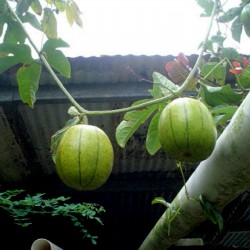
Chinese Passion Fruit Seeds...
Price
€6.25
(SKU: V 14)
Seeds Gallery EU,
5/
5
<h2 class=""><strong>Chinese Passion Fruit Seeds (Cionosicys macranthus)</strong></h2>
<h2><span style="color: #ff0000;"><strong>Price for Package of 3 seeds.</strong></span></h2>
This climbing vine in the pumpkin family is distributed from Mexico to Central America, where it grows in forests, along riverbanks and roadsides. It climbs to about 20 m and has deeply lobed leaves, creamy yellow flowers, and yellow, edible, delicious fruits, about the size of a grapefruit and similar in flavor to sweet, milky papaya. <br><br>Despite its common name in Spanish (Maracuja Chino), which translates as Chinese passion fruit, Cionosicyos macranthus is not from China and does not resemble at all a passion fruit. <br><br>It also makes a nice ornamental for tropical, humid climates.<script src="//cdn.public.n1ed.com/G3OMDFLT/widgets.js"></script>
V 14 (3 S)

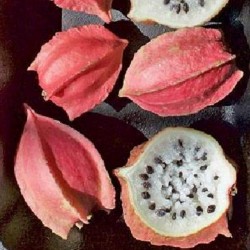
Rare Chocola Seeds (Jarilla...
Price
€18.00
(SKU: V 161 JC)
Seeds Gallery EU,
5/
5
<h2 class=""><strong>Rare Chocola Seeds (Jarilla chocola)</strong></h2>
<h2><span style="color: #ff0000;"><strong>Price for Package of 5 seeds.</strong></span></h2>
<div><span style="color: #333333; font-size: 17px;">This extraordinary papaya relative is a dry deciduous, perennial herb about 1 m tall that grows upright stems with broad, lobed leaves from a succulent underground tuber. The white and pink flowers are followed by remarkable pink fruits with five conspicuous ridges. The fruits are edible and have a very pleasant scent. <br><br>Jarilla chocola is widespread in valleys, canyons, and deciduous forests along Mexico's Pacific coast from the State of Sonora to Guatemala and El Salvador at elevations below 1300 m. <br><br>The fruits contain a white pulp with a creamy consistency and a slightly acidic taste, evoking that of a lemon. The starchy tubers could also be an interesting crop in their own right, comparable to potatoes. <br><br>In Chihuahua in northern Mexico, the locals eat the root raw or toasted and the fruit raw. Jarilla chocola is little known outside of Mexico and even less commonly cultivated. It grows best in tropical and warm temperate climates, in partial shade, and moist, well-drained soils.</span></div>
<div>
<table border="1" cellspacing="0" cellpadding="0">
<tbody>
<tr>
<td colspan="2" valign="top" width="100%">
<p><span style="color: #008000;"><strong>Sowing Instructions</strong></span></p>
</td>
</tr>
<tr>
<td valign="top" nowrap="nowrap">
<p><span style="color: #008000;"><strong>Propagation:</strong></span></p>
</td>
<td valign="top">
<p><span style="color: #008000;">Seeds / Cuttings</span></p>
</td>
</tr>
<tr>
<td valign="top" nowrap="nowrap">
<p><span style="color: #008000;"><strong>Pretreat:</strong></span></p>
</td>
<td valign="top">
<p><span style="color: #008000;">0</span></p>
</td>
</tr>
<tr>
<td valign="top" nowrap="nowrap">
<p><span style="color: #008000;"><strong>Stratification:</strong></span></p>
</td>
<td valign="top">
<p><span style="color: #008000;">0</span></p>
</td>
</tr>
<tr>
<td valign="top" nowrap="nowrap">
<p><span style="color: #008000;"><strong>Sowing Time:</strong></span></p>
</td>
<td valign="top">
<p><span style="color: #008000;">all year round</span></p>
</td>
</tr>
<tr>
<td valign="top" nowrap="nowrap">
<p><span style="color: #008000;"><strong>Sowing Depth:</strong></span></p>
</td>
<td valign="top">
<p><span style="color: #008000;">0.5 cm</span></p>
</td>
</tr>
<tr>
<td valign="top" nowrap="nowrap">
<p><span style="color: #008000;"><strong>Sowing Mix:</strong></span></p>
</td>
<td valign="top">
<p><span style="color: #008000;">Coir or sowing mix + sand or perlite</span></p>
</td>
</tr>
<tr>
<td valign="top" nowrap="nowrap">
<p><span style="color: #008000;"><strong>Germination temperature:</strong></span></p>
</td>
<td valign="top">
<p><span style="color: #008000;">about 25-28 ° C</span></p>
</td>
</tr>
<tr>
<td valign="top" nowrap="nowrap">
<p><span style="color: #008000;"><strong>Location:</strong></span></p>
</td>
<td valign="top">
<p><span style="color: #008000;">bright + keep constantly moist not wet</span></p>
</td>
</tr>
<tr>
<td valign="top" nowrap="nowrap">
<p><span style="color: #008000;"><strong>Germination Time:</strong></span></p>
</td>
<td valign="top">
<p><span style="color: #008000;">2-4 Weeks</span></p>
</td>
</tr>
<tr>
<td valign="top" nowrap="nowrap">
<p><span style="color: #008000;"><strong>Watering:</strong></span></p>
</td>
<td valign="top">
<p><span style="color: #008000;">regular watering during the growth period + dry between waterings</span></p>
</td>
</tr>
<tr>
<td valign="top" nowrap="nowrap">
<p><span style="color: #008000;"><strong> </strong></span></p>
</td>
<td valign="top">
<p><br><span style="color: #008000;"><em>Copyright © 2012 Seeds Gallery - Saatgut Galerie - Galerija semena. All Rights Reserved.</em></span></p>
</td>
</tr>
</tbody>
</table>
</div>
V 161 JC

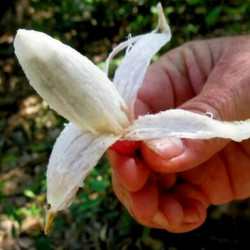
Plumiers Bromelia Seeds...
Price
€2.95
(SKU: V 62 BK)
Seeds Gallery EU,
5/
5
<h2><strong>Plumier's Bromelia Seeds (Bromelia karatas)</strong></h2>
<h2><span style="color: #ff0000;"><strong>Price for Package of 5 seeds.</strong></span></h2>
Bromelia karatas is a species of tropical plants in the Bromeliaceae family, widely distributed from the Caribbean to Central and South America. Its edible fruit is consumed by humans in fruit juice or raw.<br><br>The species is hemicryptophyte. It occurs in rosettes with short and robust stems which reproduces by runners or seedlings. The leaves are 2 to 3 meters in length and 4 to 6 centimeters in width. Strong thorns are arranged on the edge of the blade. The flowers are sessile.<br><br>The spindle-shaped greyish-yellow to red fruit is 4 to 8 centimeters in length, contains very many small black seeds in a white juicy flesh<br><br>Food use<br><br>The species is widely found in the wild but is also cultivated in hedges. Its red-skinned fruit with a flavor similar to that of the best-known species of Bromeliaceae, pineapple or Ananas comosus, is eaten raw or in fruit juice. Due to its high bromelina content, the fruit is susceptible to attack the mucous membranes of the mouth.<br><br>The fruit is known by many names, especially in Venezuela (camburito, chigüichigüe, curibijil, quiribijil, curujujul or cuscuta), in Mexico (cocuixtle, jocuiste or jocuixtle, timbiriche, timbirichi, in Cuba (maya cimarrona, maya piñon, maya de ratón), in Mexico, Colombia and Venezuela as piñuela, in Puerto Rico as piña de cuervo, in Portuguese as caraguata, carauata, coroata, croata and in French as carata , karatas, “penguin pineapple” 4 or even penguin bayyonnet.<br><br>In Mexico, especially Chiapas and the Hidalgo, the fruit is known as timbiriche and the fruit juice common in popular markets as agua de sabor. In the state of Jalisco, the fruit is known by several names, including piñuela, cocuixtle, or jocuixtle, and is eaten raw or used as the base for a taco sauce. It is also consumed in the state of Zacatecas where it is imported from Jalisco. In Peru, the juice is sucked directly from the fruit.
V 62 BK (5 S)

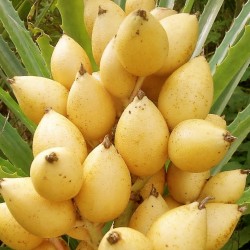
Wild Pineapple Seeds...
Price
€7.00
(SKU: V 62 BP)
Seeds Gallery EU,
5/
5
<h2 class=""><strong>Wild Pineapple Seeds (Bromelia pinguin)</strong></h2>
<h2><span style="color: #ff0000;"><strong>Price for Package of 5 seeds.</strong></span></h2>
Bromelia pinguin is a plant species in the genus Bromelia. This species is native to Central America, Mexico, the West Indies, and northern South America. It is also reportedly naturalized in Florida. It is very common in Jamaica, where it is planted as a fence around pasture lands, on account of its prickly leaves.<br /><br />This terrestrial bromeliad forms a fairly large rosette of dark green, sword-shaped leaves that are spiny along their edges. The inner leaves turn bright red when the plant produces a compact, pinkish inflorescence that is followed by yellowish fruits that are edible but highly acidic. <br /><br />The yellowish fruit that is edible, known as piñuela, peeled like a banana and eaten. They are slightly tart with a crunch from the seeds. The plant can be stripped of its pulp, soaked in water, and beaten with a wooden mallet, and it yields a fiber whence thread is made. In countries like El Salvador, it is used to make gruel.
V 62 BP (5 S)





